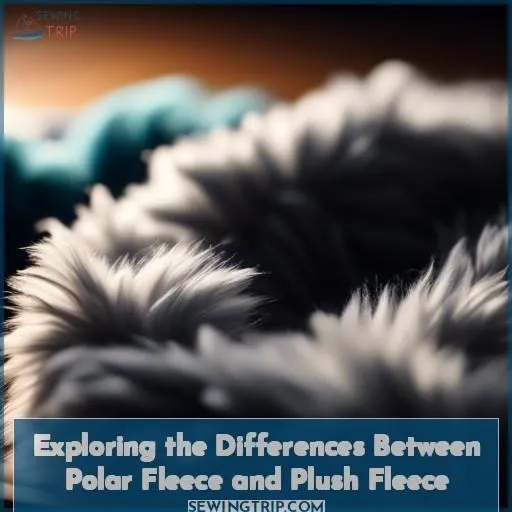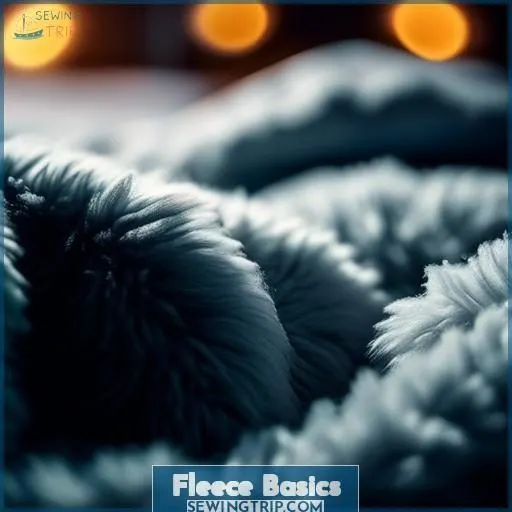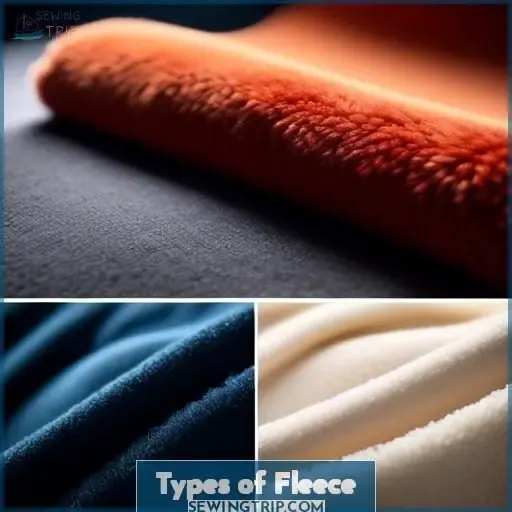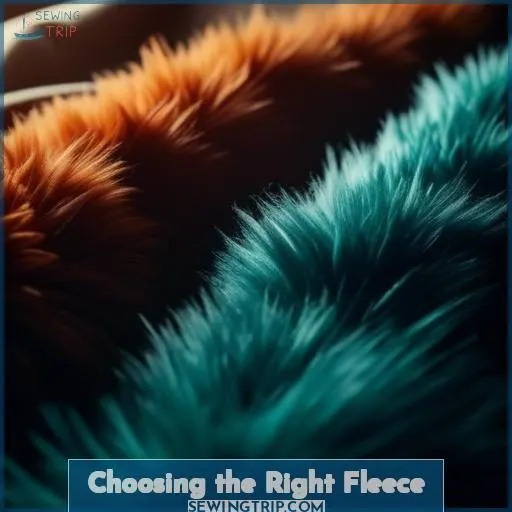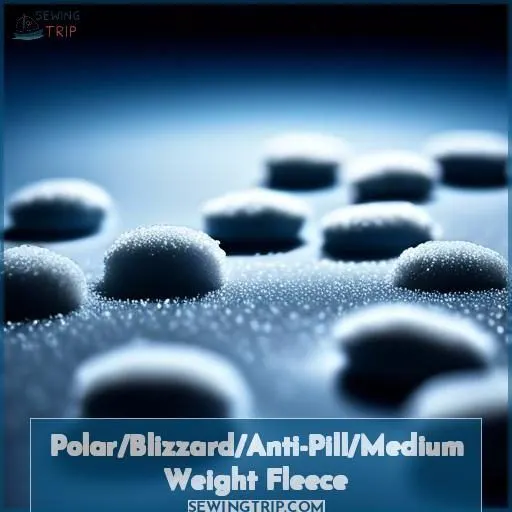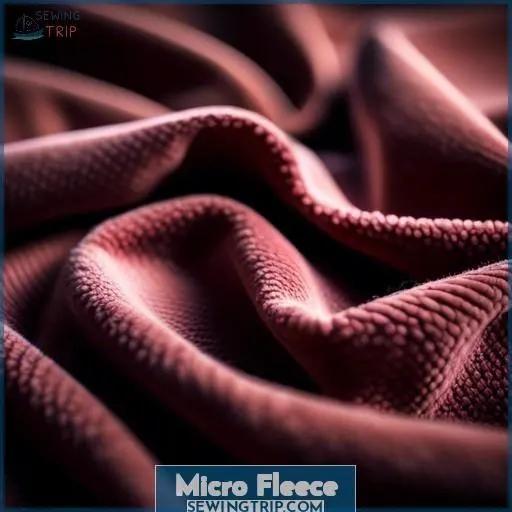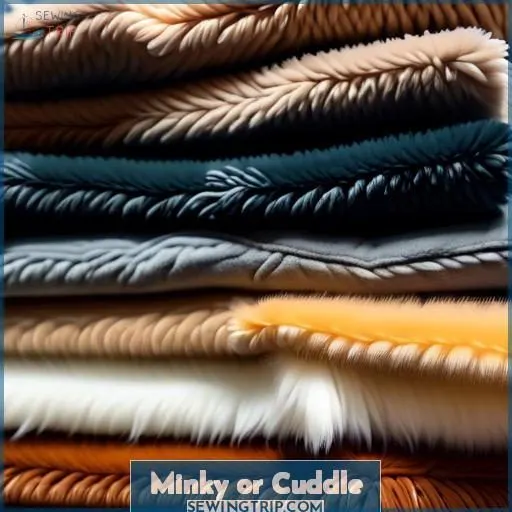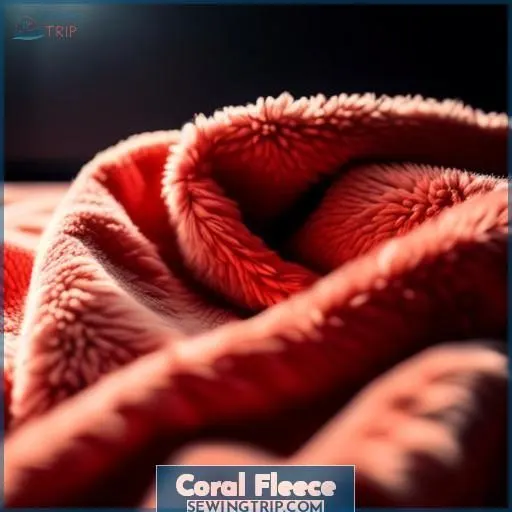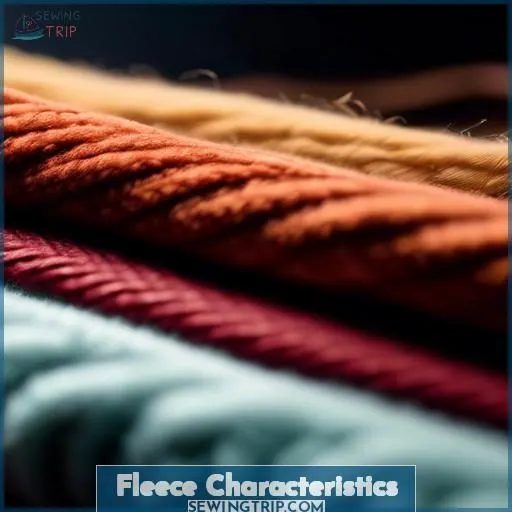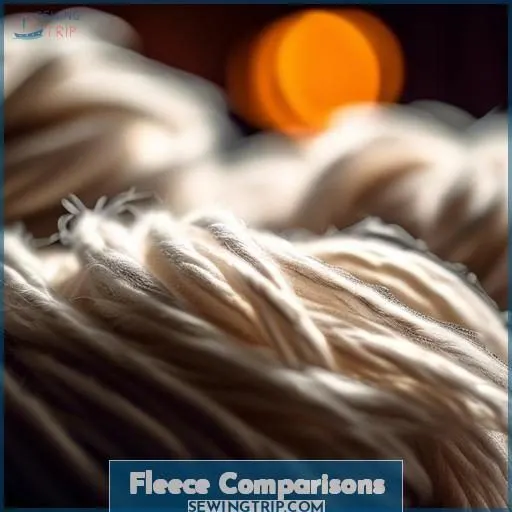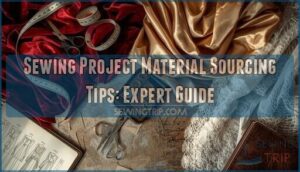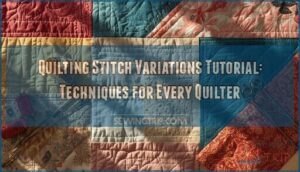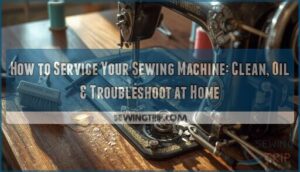This site is supported by our readers. We may earn a commission, at no cost to you, if you purchase through links.
Polar fleece and plush fleece cater to different comfort and warmth needs. Polar fleece, known for its thick, warm qualities, is ideal for blankets and jackets, effectively keeping cold at bay. It’s versatile, available in anti-pill and non-anti-pill options, and is the go-to for medium weight fabric needs.
On the other hand, plush fleece, often referred to as minky or cuddle fleece, offers a softer, more luxurious feel, making it perfect for cozy home décor and apparel. While polar fleece provides excellent insulation, plush fleece brings an unmatched softness to the table.
Exploring these differences further will guide you to the perfect fleece choice for your project.
Table Of Contents
Key Takeaways
- Polar fleece is thicker and warmer, while plush fleece is softer and more luxurious.
- Polar fleece is suitable for jackets and blankets, while plush fleece is ideal for cozy home decor and apparel.
- Polar fleece is made from polyester and is brushed on one or both sides to create a soft, plush feel, while plush fleece is made from 100% polyester and is characterized by its long, dense pile.
- Polar fleece is more suitable for outdoor clothing and gear, while plush fleece is more commonly found in bedding and decorative items where softness and texture are the primary considerations.
Fleece Basics
Fleece is a versatile fabric that offers warmth, comfort, and durability. It comes in various types, each with its unique characteristics and applications. Here’s a brief overview of fleece basics:
- Construction: Fleece is a knit fabric with a brushed side, which gives it a soft, plush feel. It’s made from various materials, including polyester, cotton, and synthetic fibers.
- Insulation: Fleece provides excellent insulation, trapping body heat and retaining it without adding bulk. The fluffy texture creates thousands of tiny air pockets that help retain heat next to your body.
- Breathability: Fleece is inherently breathable due to its porous construction, allowing for better air flow and moisture wicking than some other synthetic materials.
- Moisture Management: Fleece is designed to wick moisture away from the skin, making it ideal for performance clothing and baby items.
- Care: Fleece is generally easy to care for, but the specific care instructions may vary depending on the type of fleece.
- Eco-Friendly Options: Many fleece products are available in eco-friendly versions, made from recycled materials or with sustainable manufacturing processes.
- Types of Fleece: There are several types of fleece, including polar fleece, microfleece, and Sherpa fleece, each with its unique properties and applications.
- Choosing the Right Fleece: When selecting fleece, consider the purpose of the garment or item, the customer’s preferences, and the specific properties of the fleece type.
- Screen Printing on Fleece: Tips for screen printing on fleece include using low-heat inks and adhesives, testing prints on scrap fabric, and using flash cure to dry the ink quickly.
- Fleece vs. Plush Fleece: Polar fleece and plush fleece are both popular types of fleece, with polar fleece being more lightweight and breathable, while plush fleece is thicker and warmer.
Understanding these basics will help you make informed decisions when choosing and working with fleece.
Types of Fleece
Fleece is a versatile fabric that comes in various types, each with its unique characteristics and applications. Understanding the different types of fleece can help you choose the right fabric for your project or need. Here’s an overview of the main types of fleece:
- Cotton/Cotton Blend Fleece: This type of fleece has a smooth outer surface and a plush inner nap. It’s suitable for outerwear and clothing that requires a soft, yet durable fabric.
- Polyester Fleece: Polyester fleece has a shiny outer surface and is moisture-repellent. It’s commonly used for sportswear and activewear due to its moisture-wicking properties.
- Lycra Spandex Fleece: This stretchy fleece is ideal for fitted garments, such as leggings and activewear. It provides a comfortable fit and allows for ease of movement.
- Microfleece: Microfleece is a thin, soft fabric that wicks moisture away from the skin. It’s often used for baby and children’s clothing due to its lightweight and gentle nature.
- Polar Fleece: This thick, warm fleece is commonly used for blankets and jackets. It provides excellent insulation and is suitable for cold weather clothing.
- French Terry Fleece: French terry is an unbrushed, thin, flat fleece. It’s often used for t-shirts and other garments where a soft, comfortable fabric is desired.
- Slub Fleece: Slub fleece has a textured appearance due to twisted yarns. It’s often used for casual clothing and accessories.
- Sherpa Fleece: Sherpa fleece mimics the feel of wool fleece but is made from synthetic materials. It’s often used for outerwear and insulation.
- Water-Resistant Fleece: This type of fleece has a high polyester content or is treated with a water-resistant finish. It’s suitable for outdoor clothing and gear.
- Low-Pill Polyester Fleece: This fleece is designed to resist pilling, which is the formation of small balls of fabric on the surface of the fabric. It’s ideal for garments that require a smooth, pill-resistant surface.
When choosing the right fleece for your project, consider factors such as the fabric’s thermal properties, environmental impact, and the specific needs of your project. Different types of fleece are better suited for different applications, so understanding the characteristics of each type can help you make the best choice.
Choosing the Right Fleece
After delving into the varied realm of fleece, you now stand at a juncture: selecting the optimal fleece. It’s akin to choosing the ideal travel companion; compatibility is paramount. Here’s how to secure a harmonious match:
- Consider fleece quality and care: Plush fleece may feel akin to a warm embrace, but if you seek longevity, polar fleece or low-pill polyester could be your preferred choice.
- Weigh your options: Literally. Fleece weight influences warmth and comfort. Lighter microfleece is ideal for layering, while heavier cotton fleece keeps the cold at bay.
- Stretch your imagination: Not all fleece is created equal. Lycra spandex enhances flexibility, perfect for active wear, whereas anti-pill fleece retains its appearance longer, making it a dependable option for everyday escapades.
Selecting the appropriate fleece involves balancing fleece care, durability, and your individual requirements. Whether you’re creating a cozy haven or preparing for outdoor adventures, the right fleece can make a profound difference.
Polar/Blizzard/Anti-Pill/Medium Weight Fleece
Polar/Blizzard/Anti-Pill/Medium Weight Fleece is a versatile fabric that’s suitable for various sewing patterns and can be used for no-sew projects, such as blankets and tie blankets. It’s available in anti-pill and non-anti-pill options, with medium weight being the most common.
This type of fleece is suitable for both adults and children and is known for its ability to keep the cold away from the body, earning it the name polar.
Micro Fleece
Microfleece is a lightweight, double-sided fleece that offers a soft, comfortable texture. It’s thinner and more breathable than polar fleece, making it ideal for active pursuits in mild weather conditions. Microfleece is often used for mid-layers that can be worn over base layers and under rain jackets or waterproof jackets. It provides the lowest level of insulation but has a high breathability rate, which is beneficial for those who engage in physical exercise. Typically, any fleece up to 200 gsm or about 6 oz is considered a microfleece. It’s also frequently chosen as an outer layer when outdoor conditions are mild.
Microfleece is often used for baby and children’s projects due to its softness and lightweight nature. It has a clear right and wrong side, and the ends don’t fray but can stretch out of shape. Microfleece is thinner than medium weight fleece and isn’t recommended for no-sew projects. It requires special care when sewing, such as using a jersey ball point needle or a walking foot, and the edges may ruffle and lose shape if not finished properly. To maintain its softness, microfleece should be washed cold, without fabric softener, and dried on low.
In comparison to polar fleece, microfleece is lighter and more breathable, making it suitable for a wider range of activities and weather conditions. However, it offers less insulation than polar fleece. The choice between the two depends on the specific needs and preferences of the user.
Minky or Cuddle
Minky or Cuddle is a type of plush fleece that mimics the feel of mink fur. Here’s what you need to know about working with this fabric:
- Minky Care: Handle with care. Use a jersey ball point needle or walking foot for sewing. Wash cold, avoid fabric softener, and dry on low to maintain softness.
- Minky Durability: While it’s soft, it can be prone to ruffling and losing shape, especially at the edges.
- Minky Projects: Ideal for baby and children’s projects, as well as clothing and accessories. It’s not recommended for no-sew projects or blankets.
- Minky Sewing: Be aware of the fabric’s tendency to stretch out of shape. Use a low-heat iron to avoid melting the fibers.
- Minky Suppliers: Look for reputable suppliers to guarantee you’re getting high-quality minky or cuddle fabric.
- Warm and Cuddly: This plush fleece is perfect for creating cozy, huggable items that will keep your customers warm and comfortable.
- Comparison with Plush Fleece: While similar, minky or cuddle has a more luxurious feel and requires special care compared to other plush fleeces like coral fleece.
Coral Fleece
Coral fleece is a unique type of fleece that mimics the feel of wool. It features a fur-like texture and isn’t recommended for no-sew projects, as the edges need to be finished to prevent stretching. For care, washing in cold water, avoiding fabric softener, and drying on low heat will help maintain its softness.
Project Ideas for Coral Fleece
Coral fleece can be used for various projects, such as pet toys, blankets, and even clothing items. Its unique texture adds a touch of luxury to any creation.
Coral Fleece vs. Other Fleece
Compared to other fleece types, coral fleece has a distinct texture and care requirements. It’s not as common as polar or plush fleece, but it offers a unique look and feel that can enhance your projects.
Coral Fleece Durability
While coral fleece is durable, it does require special care to maintain its texture and softness. It’s a great choice for projects where you want to add a fur-like texture, but it may not be as suitable for everyday use as other types of fleece.
Coral Fleece Pros and Cons
Pros: Unique texture, adds luxury to projects, suitable for specific project ideas
Cons: Requires special care, not as common as other fleece types
Incorporating Coral Fleece into Your Projects
When working with coral fleece, consider its unique texture and care requirements. Use a jersey ball point needle or walking foot to sew, and be mindful of the edges to prevent stretching. With the right care, coral fleece can add a touch of luxury to your projects.
Fleece Characteristics
To truly appreciate the differences between polar fleece and plush fleece, it’s crucial to explore their distinct attributes. Polar fleece, crafted from synthetic fibers, is renowned for its intermediate weight, making it appropriate for most sewing projects. It’s available in anti-pill and non-anti-pill options, with its intermediate weight being the most prevalent choice.
Plush fleece, in contrast, is softer and thinner than polar fleece, designed for baby and children projects. It has a clear right and wrong side and is thinner than intermediate weight fleece.
Both fleece types provide varying levels of comfort and drape, making them ideal for diverse applications.
Fleece Comparisons
When comparing fleece to other materials, it’s crucial to grasp the disparities between polar fleece and plush fleece. Polar fleece is a dense, toasty fabric typically employed for jackets and blankets, whereas plush fleece is a softer, airier fabric with a brushed surface often used for loungewear and bedding.
Polar fleece is crafted from polyester fibers that are brushed to establish a soft, plush surface. It’s renowned for its warmth, moisture-wicking attributes, and hardiness. It’s frequently used for outdoor clothing and gear, as it offers insulation while remaining breathable.
Conversely, plush fleece is a variety of microfleece that’s made from finer polyester fibers. It’s lighter and more breathable than polar fleece, making it perfect for warmer weather. Plush fleece is often used for loungewear, bedding, and other lightweight attire.
When selecting between polar fleece and plush fleece, ponder the intended use of the fabric. If you require a warm, insulating fabric for outdoor clothing or gear, polar fleece is the superior choice. If you seek a soft, lightweight fabric for loungewear or bedding, plush fleece is the better option.
Differences Between Polar Fleece and Plush Fleece
Polar fleece and plush fleece are two distinct types of fleece, each with its unique characteristics and applications. While polar fleece is known for its lightweight, warm, and moisture-wicking properties, plush fleece is recognized for its soft, luxurious texture and high pile.
Polar fleece is made from polyester and is brushed on one or both sides to create a soft, plush feel. It’s commonly used in jackets, hats, and blankets, as well as in high-performance outdoor clothing. On the other hand, plush fleece is typically made from 100% polyester and is characterized by its long, dense pile, which gives it a velvety texture. This type of fleece is often used in blankets, pillows, and other bedding accessories, as well as in clothing and accessories where a soft, luxurious feel is desired.
One key difference between the two is their pile structure. Polar fleece has a two-sided pile, meaning it’s fluffy on both sides, while plush fleece has a single-sided pile, with the plush texture only on one side. Additionally, polar fleece is often used in jackets and other clothing items where insulation and moisture-wicking properties are important, while plush fleece is more commonly found in bedding and decorative items where softness and texture are the primary considerations.
Frequently Asked Questions (FAQs)
What is the difference between polar fleece and plush fleece in terms of texture?
Polar fleece has a thicker texture than plush fleece, providing better insulation and warmth. Plush fleece, on the other hand, has a softer texture, making it more suitable for comfort and casual wear.
Are there any specific care instructions for washing and drying polar fleece and plush fleece?
To keep your polar fleece and plush fleece looking and feeling their best, follow these care instructions:
- Wash your fleece garments in cold water on the hand wash or delicate cycle, using a mild detergent designed for delicate fabrics. Avoid using bleach or fabric softener, as they can damage the fibers and affect the fabric’s softness.
- Tumble dry your fleece items on a low heat setting or hang them outside to air dry. If you must use a dryer, opt for the lowest heat setting to prevent heat damage.
- After washing and drying, use a fabric brush gently to restore fluffiness and remove any lint or debris. If the material has lost its softness, a fabric softener can help, but use it sparingly to avoid unwanted build-up on the textile.
- When storing your polar fleece garments, avoid folding and instead hang them in a cool place without direct sunlight, as light can fade the colors. Keep the container or closet dry to prevent the growth of mildew, and consider storing your fleece with lavender or cedar chips as a natural moth repellant.
What are the best uses for polar fleece and plush fleece in terms of clothing and bedding?
Polar fleece shines in jackets and blankets, offering warmth without the weight. Plush fleece, with its luxurious feel, is perfect for cozy bedding and soft loungewear, wrapping you in comfort like a warm hug.
How does the composition of polar fleece and plush fleece affect their performance and durability?
The composition of polar fleece and plush fleece affects their performance and durability in several ways. Polar fleece is typically made from polyester, which is a synthetic fiber known for its hydrophobic properties, meaning it repels moisture and dries quickly. This makes polar fleece an excellent choice for outdoor activities and cold weather clothing, as it retains its insulating qualities even when wet. However, the hydrophobic nature of polyester can also make it more susceptible to static electricity, which can lead to the accumulation of lint, dust, and pet hair. Additionally, lower-quality polyester fleece is prone to pilling, where the fibers break and reform into tiny balls on the surface of the fabric.
On the other hand, plush fleece is often made from a blend of materials, such as cotton or lycra spandex, which can result in a softer, more plush feel compared to polar fleece. These blends can also offer different properties, such as stretchiness with lycra spandex or moisture-wicking with cotton. However, the blend of materials can also affect the fabric’s durability, as cotton is more prone to shrinking with heat exposure, and lycra spandex can lose its elasticity over time.
In terms of choosing the right fleece for your needs, consider the garment’s purpose and the customer’s requests. For example, polar fleece is suitable for most sewing patterns and can be used for no-sew projects, while plush fleece might be better for garments that require a softer, more plush feel. Additionally, consider the fabric’s durability, as some blends may be more prone to shrinking or losing their shape over time.
When screen printing on fleece, it’s imperative to use low-heat inks and adhesives to avoid damaging the fabric. Test prints on scrap fabric before printing on the final garment, and avoid overprinting to prevent potential issues. Use flash cure to dry the ink quickly and allow the garments to cool before handling to prevent any potential shrinking or damage.
Are there any eco-friendly options available for polar fleece and plush fleece?
Yes, there are eco-friendly options available for both polar fleece and plush fleece. For polar fleece, you can find 100% recycled polyester options that are environmentally friendly and built to last.
For plush fleece, you can consider using recycled cotton or organic cotton blends, which are more sustainable alternatives.
Additionally, some brands and manufacturers are adopting eco-friendly initiatives in fleece production, such as reducing water and energy consumption, implementing recycling programs, and using alternative materials like organic cotton or recycled fibers.
Conclusion
Envision yourself commencing a winter endeavor, where the selection between polar fleece and plush fleece becomes pivotal. Polar fleece boasts the thickness and warmth imperative for garments designed for the outdoors, while plush fleece, with its velvety softness, enhances household adornments and comfortable garments.
Grasping the distinctions between polar fleece and plush fleece guarantees you pick the ideal material for your requirements, harmonizing comfort with practicality. This guide has furnished you with the wisdom to make a discerning decision, customizing your projects to perfection.

